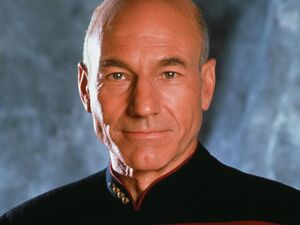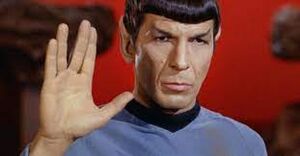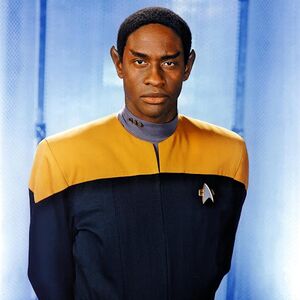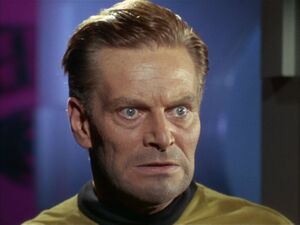Command Department
More actions
The Command Department includes both the senior-most officers of the unit, as well as administrative support personnel. On the largest units (such as starbases) there can be dozens of people in the command department, while on smaller units it may just be the senior officers and a yeoman or two. Smaller units also often combine command-related departments such as Strategic Operations, Intelligence or Diplomacy, if officers in those specialties are present.
Duties
The Command Department has some of the most complex duties of any department in any unit, with wide-ranging responsibility for the safety of their command, being the final word on navigation, engineering readiness, security, crew discipline, and even diplomatic decisions that might have repercussions for the entire Federation. The buck stops with the Command Department and the captain, on every non-medical issue.
- Carry out the orders of Starfleet, and represent the United Federation of Planets.
- Ensure all departments are properly staffed with qualified personnel, and supervise all departments in the performance of their duties.
- Ensure the safe navigation and readiness of their unit.
- Serve as the ultimate disciplinary authority within their unit, up to and including recommending courts-martial when necessary.
Standard Command Positions
Commanding Officer

Starships are rarely commanded directly by flag officers more senior than commodores. For the flagships of more senior officers, it is very common for the ship to have its own captain, who handles the day-to-day running of the ship. Historically, this officer would be called a flag captain, but the use of this term varies based on officers' preferences. Typically, a flag captain is relatively junior in seniority, given that they are closely supervised by their flag officer.
The captain of a starship has significant powers deriving from the difficulty of real-time contact with Starfleet, including the power to negotiate treaties and trade agreements when out of touch with Command. They also have authority over lesser vessels (such as tankers, freighters, passenger ships, etc.) during emergency situations. Similarly, commanding officers of starbases are often the senior-most officer in their sector with corresponding authority over starships in that sector.
Executive Officer / First Officer

First officers have important responsibilities in several emergency and contingency protocols, including needing to concur with the commanding officer's decision to self-destruct the ship or station in most circumstances, and needing to concur with the opinion of both the ship's counselor and the chief medical officer in circumstances where the commanding officer must be relieved of duty.
On larger commands, this role is most often separate, but on smaller vessels (and historically in Starfleet) it is often a dual-role for one of the department heads. In this case, they wear the color of the department that they also head.
Second Officer

The very largest commands such as major starbases might have a dedicated second officer within the command department, but this is uncommon aboard the average station or starship.
Yeoman

Additional Command Positions
Larger units often have additional command department personnel, both holding watches on the bridge and assisting the Commanding Officer and Executive Officer in the performance of their duties.
Officer of the Watch
It is standard practice to have bridge-qualified department heads take the conn (i.e. command the bridge or operations center) when the captain, first officer, or second officer are otherwise occupied. Some starships have additional command department personnel who routinely stand watch on the bridge; most often this is a dedicated night-shift officer of the watch, but the largest ships might have up to six or seven officers between the rank of lieutenant junior grade and commander who are assigned to specific watches. This is more common aboard stations.
Protocol Officer
Protocol Officers specialize in the fine nuances of statecraft, which ranges from how to seat guests of different societal and military ranks at a dinner party to the proper uniforms and flags to be employed in formal ceremonies to the correct forms of address for every ambassador, monarch, and general that might interact with their unit. Starships might also have a protocol officer, especially if they are assigned to diplomatic duties, but this role is often filled instead by the Ship's Counselor. On stations, this role would instead be under Diplomatic Affairs.
Command Master Chief
The Command Master Chief is the senior-most enlisted member of a unit, and might have additional responsibilities related to meeting the needs of the unit's enlisted population. This responsibility overlaps with the executive officer's responsibility for crew readiness and the counselor's responsibility to help address crew needs. While not all units have someone in this role, its value is in being able to provide the perspective of someone who's successfully navigated an enlisted career path to help train other enlisted personnel. As suggested by the name, this is generally a master chief petty officer, but lower enlisted grades could hold a modified title (Command Senior Chief, Command Chief, etc.) if necessary.
Administrative Section
On the very largest units, the Command Department might have an Administrative Section, led by the Administrative Officer, under which personnel such as yeomen, records officer, and personnel officers would fall, as the number of people in these roles would require more oversight than would be feasible for the Executive Officer, who must think of the whole ship.
Administrative Officer
A unit with a records officer, personnel officer, and multiple yeomen might have an Administrative Officer, who leads the ship's Administrative Section. This officer would coordinate the duty schedules for this section, taking that burden from the Executive Officer. Such an officer might also serve as a senior advisor to the commanding officer. Typically, only the largest ships would have an officer in this role, but it would be vital for most starbases who might have dozens of yeomen, personnel officers, and records officers to manage.
Records Officer

Personnel Officer
A unit's personnel officer is an assistant to the Executive Officer in their duties of compiling duty rosters, performing crew evaluations, and making sure that crewmembers' dossiers are kept up-to-date. They work alongside the Records Officer.
Station and Starbase-Specific Sections
Large stations and nearly every starbase will have additional Command Division sections related to the needs of hosting civilians and diplomats in a Starfleet context.
Civilian Affairs Section
Stations and starbases with large civilian populations generally have a section with at least one officer dedicated to meeting the needs of residents, as well as ensuring that residents follow the relevant Starfleet protocols when it comes to safety, conduct, and property use. This section handles everything from quarters assignments to conflict resolution, items which would otherwise fall to the Commanding or Executive Officer.
Civilian Affairs Officer
Civilian Affairs Officers manage the needs of a station's civilian population, especially with regard to housing, resource requirements, and dispute resolution. They serve as the interface between civilians and the station's command staff, as well as civilians' advocates and voices in decisions that might impact them.
Civilian Affairs Specialist
Civilian Affairs Specialists are enlisted support staff in the Civilian Affairs section.
Public Relations Officer
Public Relations Officers are responsible for producing bulletins and informational materials for the station's residents, ranging from news updates to briefings on safety and security. On the largest stations, this might include broadcasts in several different genres, while on smaller bases it might just be a newsletter. They also field questions from the media on behalf of the Commanding Officer or any other department head.
Public Relations Specialist
Public Relations Specialists are enlisted support staff that assist Public Relations Officers.
Diplomatic Affairs Section
Many large starbases have embassies from various Federation worlds and foreign powers. It is the job of Diplomatic Affairs to work out issues related to space and housing for diplomats, to mediate disputes between various embassies' staffs, and, in general, to make sure the needs of consular personnel are met. Officers from this section must be experienced in interstellar relations and are often called upon to advise the station's commander on how best to proceed when dealing with local diplomats. Diplomatic Affairs also helps beings of all nationalities reach the appropriate consular officer, whether that help can be found on the station or not.
Diplomatic Affairs Officer
Diplomatic Affairs Officers are the interface between diplomats and consular officials working out of a particular station with that station's command staff. They insulate the Commanding Officer from having to respond to the many minor demands that embassies would make on a daily basis. Their role is not to represent the Federation, but to keep the mechanisms of consular services running smoothly, and to handle logistical tasks, but given their closeness to the ambassadors they work with, they are also able to advise their commanding officers in negotiations.
Diplomatic Affairs Specialist
Diplomatic Affairs Specialists are enlisted personnel in the Diplomatic Affairs department, whose duties range from helping set up for formal events to running errands on behalf of diplomats to working out the finer details and paperwork of various agreements.
Flag Officer Support Positions
Flag Officers are generally supported by several line officers in staff roles, the number and seniority of which depend on the seniority and importance of the flag officer themselves. These positions would be found aboard starships and starbases that embark flag officers. In addition to the positions listed here, a Flag Officer might have their own Strategic Operations Officer, Intelligence Officer, Protocol Officer, or any other necessary role.
Adjutant / Chief of Staff / Executive Officer

The role has multiple titles depending on the specifics of a flag officer's mandate, but an adjutant is a senior line officer who assists a flag officer in carrying out their duties. Distinct from a Deputy (who has their own command authority within a task force, fleet, or other unit), they derive authority from their flag officer and are often asked to transmit orders to subordinates. They also oversee the flag officer's other staff. Commodores and Rear Admirals would have commander or captain, Vice Admirals and Admirals would have a commodore or rear admiral, and Fleet Admirals would have a vice admiral.
Aide-de-Camp / Flag Lieutenant
Flag officers are entitled to one or more junior officers to assist them in their day-to-day duties, generally in tasks related to protocol, serving meals, etc., as an enlisted yeoman would to a line officer. On a starbase, they are called Aides-de-Camp, while for officers with field assignments they are called Flag Lieutenants. Typically, Commodores and Rear Admirals would have a lieutenant or lieutenant commander, Vice Admirals and Admirals would have a commander or captain, and Fleet Admirals would have a captain or fleet captain. Aides-de-camp wear distinctive honor cords (called aiguillettes) to signify their role.
Command Judge-Advocate
Main Article: Judge-Advocate General's Corps Detachment
Most flag officers would have a senior JAG officer on their staff, to advise them in legal matters. As with other roles, their rank would be dependent on the flag officer's rank.
The Command Department In-Play
- This is both the most important and the smallest major department aboard any ship or base.
- Only very large ships or stations would have many people in this department beyond the CO and XO.
- Officers of the Watch have likely been seen on screen (for example the officer in command of the Prometheus on DS9 held the rank of either lieutenant junior grade or lieutenant commander (depending on if we accept the costume or how he was addressed) and may have been an Officer of the Watch rather than the ship's captain) but the idea here is 'extra' command-division junior officers who are specifically there to take over the bridge when necessary, especially on larger ships and starbases.
